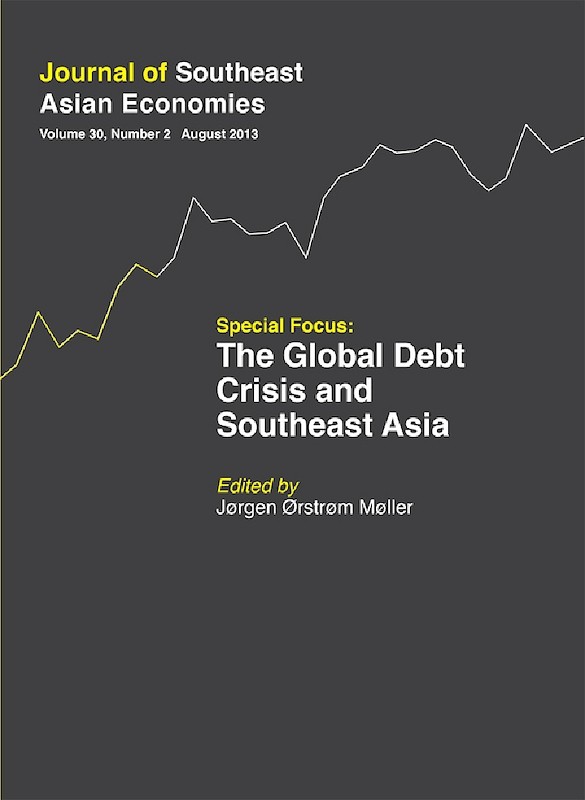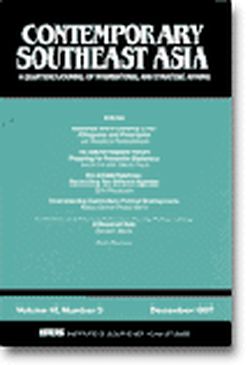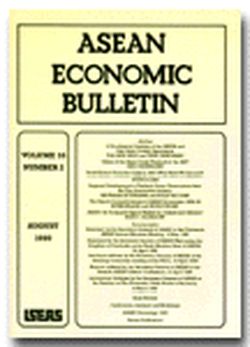Journal of Southeast Asian Economies Vol. 30/2 (Aug 2013). Special focus on "The Global Debt Crisis and Southeast Asia"

Jørgen Ørstrøm Møller, editor
Date of publication:
August 2013
Publisher:
Institute of Southeast Asian Studies
Number of pages:
120
Code:
AE30/2
Contents
-
Journal of Southeast Asian Economies Vol. 30/2 (Aug 2013). Special focus on "The Global Debt Crisis and Southeast Asia"
[Whole Publication] -
Preliminary pages
- ARTICLES
-
Introduction and Overview, by Jørgen Ørstrøm Møller, author see abstractThe global debt crisis will keep the world economy in a straitjacket for some time and reinforce the shift from established economic powers to Asia. Debt needs to be repaid in the form of lower consumption and the deleveraging process for the G-3 (the United States, the eurozone, and Japan, who have reached an unprecedented level of debt), still has a long way to go. The United States opted for fiscal and monetary stimulus, the eurozone chose austerity, and Japan after some hesitation started to pump money into the economy. It remains to be seen whether the divergence in policies will constitute a barrier for a global recovery. Southeast Asia has so far managed quite well because the lesson was learned in 1997–98 and signs of strong borrowing have been detected only recently. The main problem seems to be how to plug into a new and amended global financial system that has emerged in response to flaws that were identified when the crisis struck.
-
ASEAN Financial Integration in the Light of Recent European Experiences, by Ulrich Volz, author see abstractThis article reflects on the ambitions of the Association of Southeast Asian Nations (ASEAN) to foster regional economic and financial integration among its member countries against the backdrop of the European financial crisis. Based on a review of the European experiences with financial integration since the 1970s, this article critically examines the potential risks associated with the creation of a financially integrated ASEAN Economic Community and the implications for policy autonomy of ASEAN members. It outlines the regulatory and institutional requirements that need to be put in place in order to minimize financial stability risk if an integrated financial sector across ASEAN is aimed for. <br>
-
The Global Debt Crisis and the Shift of Japan’s Economic Relations with Southeast Asia, by Martin Schulz, author see abstractTwenty years of slow growth and depression in Japan had a strong impact on relations with Southeast Asia. An explosion of public debt to 235 per cent of GDP has greatly reduced the ability of Japan’s government to manoeuvre and has shrunk its overseas development assistance (ODA) contributions to the lowest levels of major donors. While its population was ageing, markets shrinking, and corporations restructuring, Japan became more inwardlooking. East Asia, at the same time, was catching up and now represents the world’s most dynamic market. Today, Southeast Asia is not only the base for Japan-centred production and supply chains, but the focal point of future-oriented market investment. The article will follow the stage of Japan’s “lost” decades, its evolving debt crisis, and show why the country will have to focus on much closer integration with Southeast Asia in the future.
-
American Defence Policy and the Challenge of Austerity: Some Implications for Southeast Asia, by Michael Evans, author see abstractThis article examines the Obama administration’s attempt to rebalance U.S. strategy towards the Asia-Pacific region with special emphasis on Southeast Asia. It argues that America’s regional pivot is occurring at a time of unprecedented domestic fiscal austerity caused by a staggering level of national debt. The U.S. domestic budget crisis, the current “declinist” debate, concern over the rise of China, and the impact of sequestration on American defence spending are analysed and their implications for Southeast Asia are assessed. The article suggests that the most serious aspect of the U.S. debt crisis may be its impact upon American strategic resilience and geopolitical confidence. Thus, while many ASEAN nations have welcomed the U.S. strategic pivot as a valuable reinforcement of their security, they remain unsure that it is a sustainable policy. In the future, it is likely that reassuring ASEAN of the longevity of the U.S. commitment to the Asia-Pacific will require of Washington a skilled blend of budgetary reform, military presence, and sustained diplomatic effort.
-
Impact of Eurozone Financial Shocks on Southeast Asian Economies, by Jayant Menon, Thiam Hee Ng, authors see abstractFive years after the global financial crisis, the economies of the United States and the eurozone continue to struggle. How will Southeast Asian economies be affected should there be a further deterioration in conditions in the eurozone? In this paper, we present estimates using a Global Vector Autoregression (GVAR) model of the direct impacts of a further shock to the eurozone. We find that although the direct impacts are likely to be muted, it could trigger a much larger adjustment should it lead to a reassessment of risks and asset valuations. This is a real possibility given that vulnerability in the region has increased following massive inflows of capital and build-up of debt, related to successive bouts of quantitative easing in the United States initially, and now Japan. Should this happen, and with the IMF’s resources already stretched, there is a pressing need to improve regional financial safety nets, which are currently unworkable, to deal with the fallout.
-
The Effects of Global Debt Problems on the ASEAN Economy, by Djamester A. Simarmata, author see abstractThe Global Financial Crisis and the subsequent eurozone crisis magnified the large debt accumulated by developed countries, particularly the United States. There have been several stimulus attempts in the form of quantitative easing in both the United States and in Europe. However, the results have not been satisfactory. Limited growth in the developed regions will have an impact on ASEAN due to its dependency on exports. At present, ASEAN intercountry trade is low and is therefore unable to substitute for the loss of exports to developed economies. Thus, a new paradigm has to be created to provide other avenues of growth. The most probable drivers of growth come from two sources: empowering domestic consumers to boost consumption and spending; and intensifying trade with other countries in the region. The former policy should be designed in a manner where a rise in local demand will not trigger a price hike attributable to an increase in the unit cost of production. The latter policy should stimulate trade flows in the region through the provision of additional infrastructure, as the current foundation is insufficient.
- RESEARCH NOTE
-
The Political Economy of an EU-Malaysia FTA, by Christopher Napoli, author see abstractIn September 2010, the European Union (EU) and Malaysia began negotiating a free trade agreement (FTA). This paper examines the prospects and challenges facing the EU-Malaysia FTA negotiations from a political economy perspective. It will argue two points. First, while a deep FTA would offer significant welfare gains to Malaysia, a deep agreement is unlikely to be negotiated. This is because of the difficulty Malaysia would have in opening its services markets and changing investment regulations. Second, even a deep FTA would be of little economic or strategic use for the EU. Both points beg the question: why bother negotiating an FTA?
- BOOK REVIEWS
-
BOOK REVIEW: Ordering Power: Contentious Politics and Authoritarian Leviathans in Southeast Asia, by Dan Slater., by Matthew Linley, author
-
BOOK REVIEW: Malaysia’s Development Challenges: Graduating from the Middle, edited by Hal Hill, Tham Siew Yean, and Ragayah Haji Mat Zin., by Guanie Lim, author
-
BOOK REVIEW: No Miracle: What Asia Can Teach All Countries About Growth, by Mitchell Wigdor., by Laurids S Lauridsen, author
-
BOOK REVIEW: The Capability Approach: Development Practice and Public Policy in the Asia-Pacific Region, edited by Francis Panzironi and Katherine Gelber., by Peter Larmour, author


![Journal of Southeast Asian Economies Vol. 30/1 (Apr 2013) [formerly ASEAN Economic Bulletin]](/cover/AE30-1.jpg)


